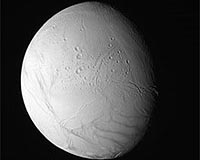 |
Pasadena CA (SPX) Nov 05, 2009 The Cassini spacecraft has weathered the Monday, Nov. 2, flyby of Saturn's moon Enceladus in good health and has been sending images and data of the encounter back to Earth. Cassini had approached Enceladus more closely before, but this passage took the spacecraft on its deepest plunge yet through the heart of the plume shooting out from the south polar region. Scientists are eagerly sifting through the results. In the unprocessed image above (top left), sunlight brightens a crescent curve along the edge of Enceladus and highlights the moon's misty plume. The image was captured by Cassini's narrow-angle camera as the spacecraft passed about 190,000 kilometers (120,000 miles) over the moon. Another raw image (top right) appears to show separate jets spewing from the moon. This image was taken from approximately 330,000 kilometers (200,000 miles) away. At its closest point on Nov. 2, Cassini flew about 100 kilometers (60 miles) above the surface of Enceladus. Since the discovery of the plume in 2005, scientists have been captivated by the enigmatic jets. Previous flybys detected water vapor, sodium and organic molecules, but scientists need to know more about the plume's composition and density to characterize the source, possibly a liquid ocean under the moon's icy surface. It would also help them determine whether Enceladus has the conditions necessary for life. Mission managers did extensive studies to make sure the spacecraft could fly safely through the plumes and not use an excessive amount of propellant. Share This Article With Planet Earth
Related Links Cassini spacecraft Explore The Ring World of Saturn and her moons Jupiter and its Moons The million outer planets of a star called Sol News Flash at Mercury
 Taking The Plunge: Cassini Soars By Enceladus
Taking The Plunge: Cassini Soars By EnceladusPasadena CA (SPX) Nov 02, 2009 After so many close flybys of Enceladus, we're starting to feel as if this little moon of Saturn is an old friend. But during the encounter planned for Nov. 2, 2009, we are going to get up-close and personal. Cassini is going to take its deepest dive yet into the plumes spewing out from the moon's south pole to try to learn more about their composition and density. The spacecraft is going ... read more |
|
| The content herein, unless otherwise known to be public domain, are Copyright 1995-2009 - SpaceDaily. AFP and UPI Wire Stories are copyright Agence France-Presse and United Press International. ESA Portal Reports are copyright European Space Agency. All NASA sourced material is public domain. Additional copyrights may apply in whole or part to other bona fide parties. Advertising does not imply endorsement,agreement or approval of any opinions, statements or information provided by SpaceDaily on any Web page published or hosted by SpaceDaily. Privacy Statement |